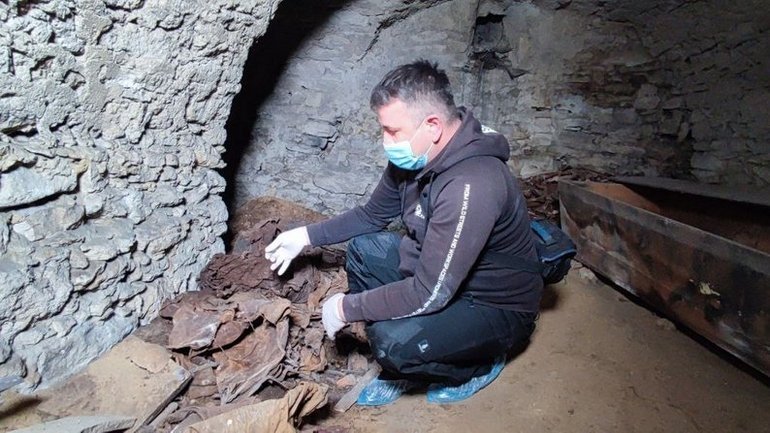Robbed burials discovered beneath St. Nicholas Cathedral in Kremenets

This was reported to Suspilne by Vasyl Ilchyshyn, the director of the Kremenets-Pochaiv Historical and Architectural Reserve. He speculates that thousands of people may have been buried here.
According to him, the cathedral was under the jurisdiction of representatives of the Moscow Patriarchate, but it was transferred to the reserve in November of last year.
"We are witnessing a horrifying scene of looting: piles of clothes and broken coffins. And behind me, there is a heap of bones from the graves. That is, they deliberately removed them from the graves, shook out the bones, piled the clothes in one heap, and other items in another, specifically searching for valuable items that were contained in the burials. Even from children's burials, torn metal crosses were taken, which could have been made of precious metals. It is evident that some of the burials, which were on the surface here, have been tampered with. Moreover, they were also dug into the floor to search for older burials. In the church's crypts, the most esteemed people, parishioners of the church, were buried - these were patrons, donors who contributed funds for the construction of the church."
Vasyl Ilchyshyn says he plans to document all the damage and contact the police because he believes the previous owners violated Ukrainian law.
"There are mentions that in the 90s, during repair works, representatives of the Moscow Patriarchate came here, but they found out that these were Catholic burials, and the matter was closed. But according to Ukrainian legislation, after the discovery of such bones, if it is not a criminal matter, then the heritage conservation authority, archaeologists, who must make their conclusion that, yes, these are Christian burials, they need to be studied and then reburied. And what do we see here? They did not contact the heritage conservation authority, they simply discovered these burials."
The current priest, Father Viacheslav Saveliev, assisted in finding the entrance to the crypts. He says the widest ventilation shaft, through which one could reach the crypts, was bricked up with gas blocks and sealed with mounting foam.
"We have been thinking about this issue for a very long time. Vasyl Ilchyshyn repeatedly asked to look for an entrance somewhere because there definitely is one, because if you look around the perimeter of the cathedral, if you walk around, there are many ventilation shafts, which definitely indicate that there are basements. In the end, these remains will have to be reburied, the burial ceremony completed, because the deceased, their remains must be buried, given to the earth, and rest in peace."
The church was built by the Franciscan order of monks, according to Dr. Iryna Skakalska, a doctor of historical sciences.
"This period is poorly researched, and the discovery of new information, finding new artifacts will complement the history of the Franciscan monastery. The Franciscans are an order that was founded in Italy by St. Francis of Assisi and was also called the Order of Friars Minor. There is a description from 1668, and this description is currently in manuscript form in the library of Vilnius University. And there are listed items that were in the church. And these crypts are also mentioned inadvertently. In 1832, this church was handed over to the Orthodox after an unsuccessful Polish uprising, to the Russian Orthodox Church."
Vasyl Ilchyshyn says they will now search for funding and archaeologists for the study of the findings and will turn to the police.
Suspilne correspondents called the former priest, Father Vasyl Vozniuk, for comment on this situation. He replied that he would not comment as he was unaware of the existence of the crypts.









